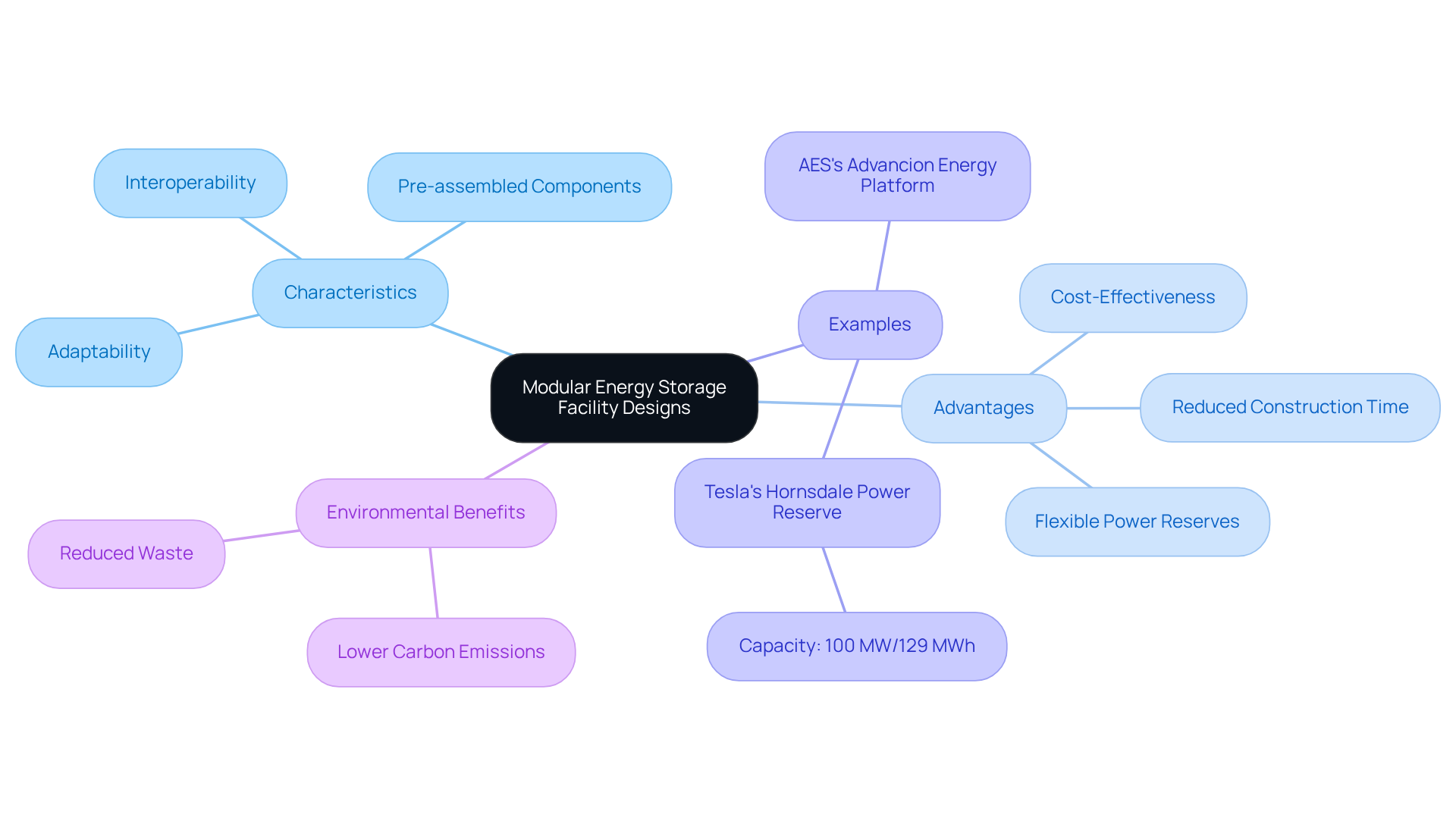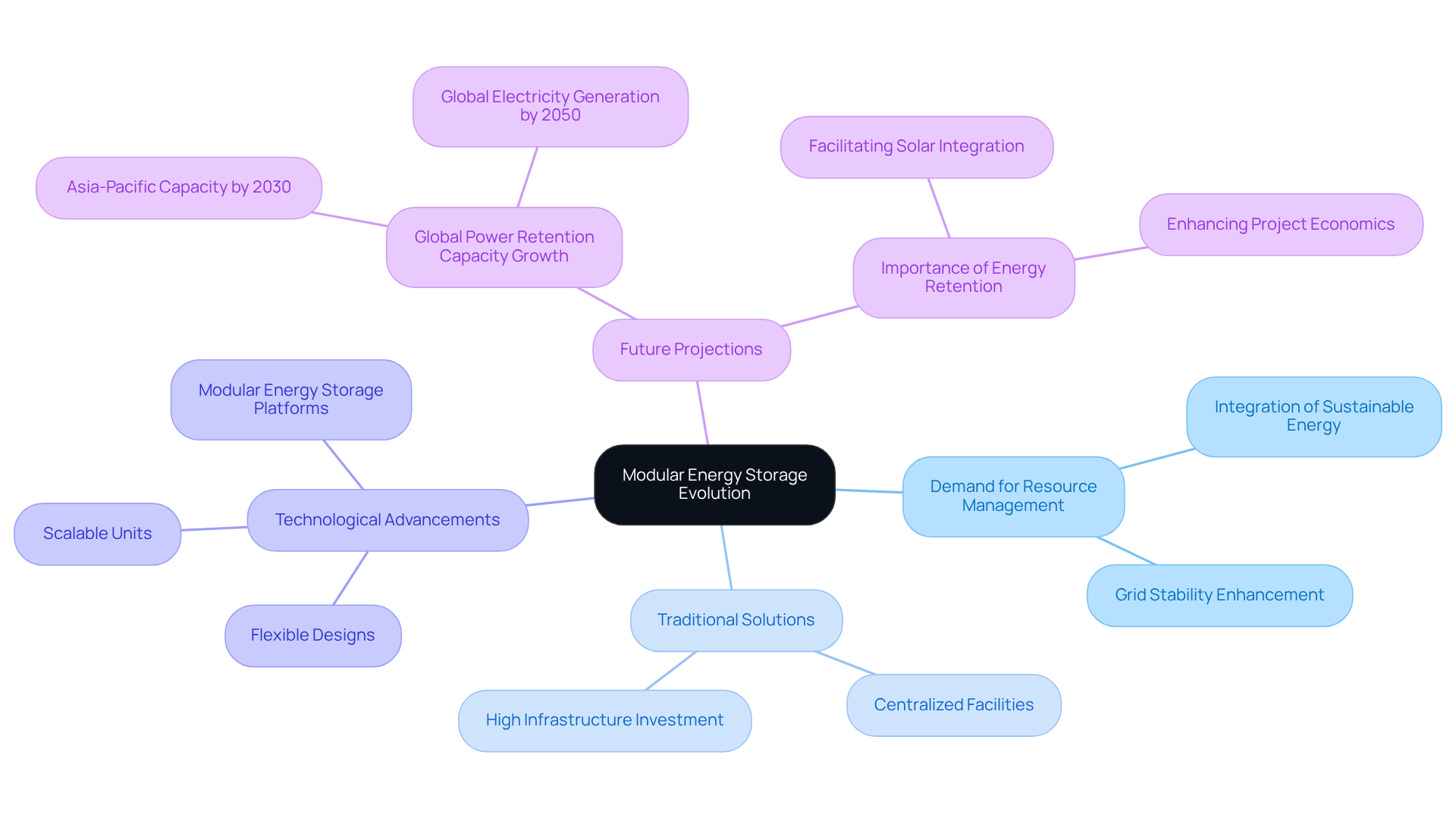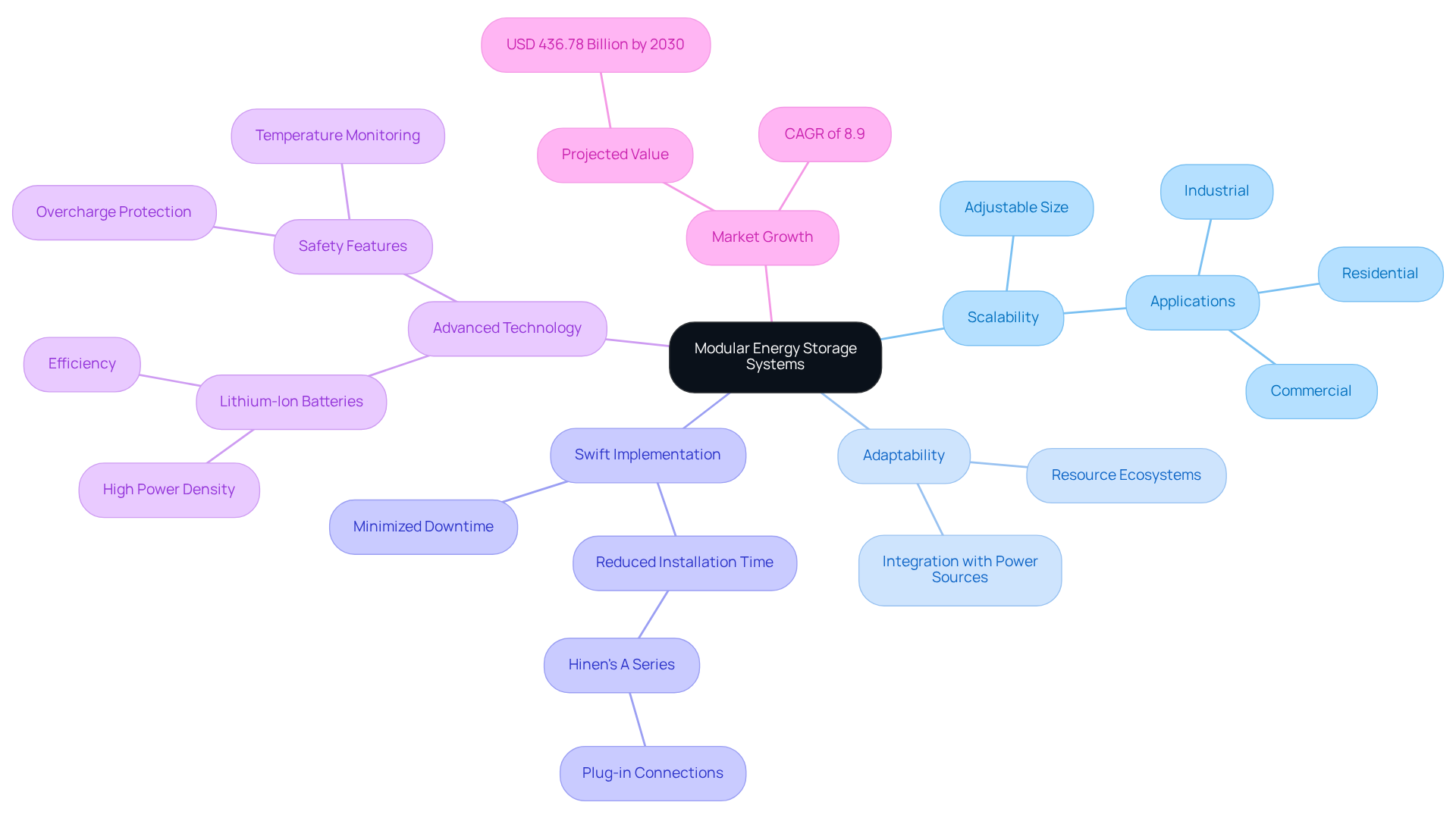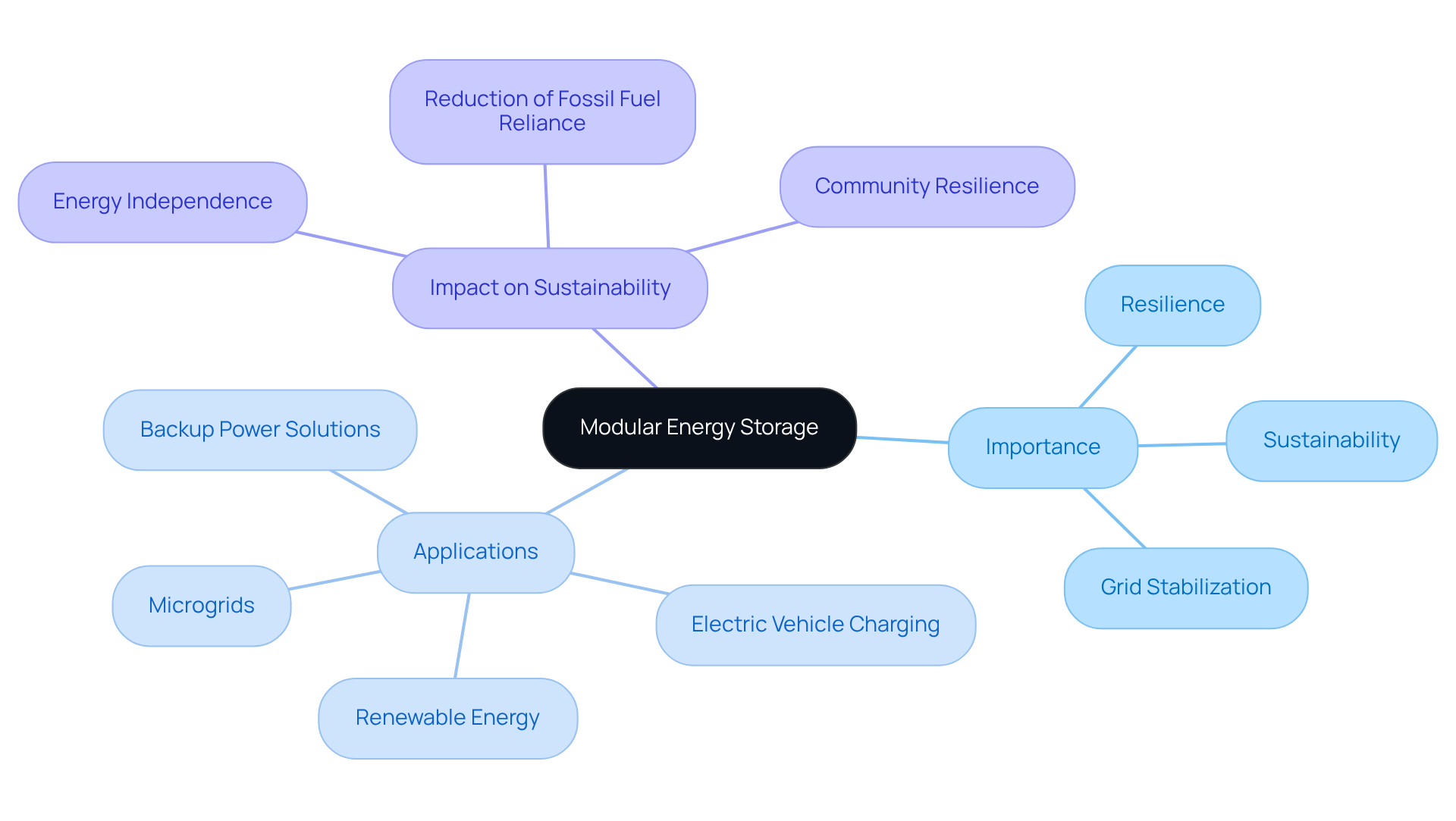Overview
Modular energy storage facility designs are crucial for efficient power management. They offer scalable and adaptable solutions that significantly enhance energy retention and integration with renewable sources. By reducing construction time and costs, these designs not only improve grid stability but also support a variety of applications. This approach effectively addresses the increasing demand for sustainable energy solutions. As we navigate the complexities of land acquisition, including legal and regulatory hurdles, it becomes clear that these innovative designs are not just beneficial but essential in meeting our energy needs.
Introduction
The increasing demand for efficient energy management solutions has catalyzed the emergence of modular energy storage facility designs, offering a flexible and scalable approach to power retention. These innovative systems not only facilitate the integration of renewable energy sources but also promise substantial economic advantages through shortened construction times and reduced costs. Yet, as the energy landscape continues to evolve, one must consider: how can modular designs effectively tackle the challenges of grid stability and resource management while accommodating the surging global power demands?
Define Modular Energy Storage Facility Designs
Modular energy storage facility designs present a compelling solution to the pressing need for efficient power management. Modular energy storage facility designs are architectural and engineering frameworks that enable power retention in a segmented format, ensuring adaptability to specific project requirements. Typically, these structures consist of pre-assembled components that can be swiftly implemented and expanded to meet varying power demands. By integrating flexible power reserves with renewable sources such as solar and wind, modular energy storage facility designs can store surplus energy generated during peak periods for future use, significantly enhancing overall reliability.
This flexible approach not only accommodates capacity changes but also substantially reduces construction time and costs, making it an economically viable option. For instance, flexible power containment solutions can range from small household systems to large-scale industrial applications, showcasing remarkable adaptability. Furthermore, the use of standardized components in these facilities improves interoperability and simplifies maintenance, allowing users to replace only malfunctioning modules rather than entire systems, thus minimizing downtime.
As the demand for effective power retention solutions continues to grow, modular energy storage facility designs are becoming increasingly vital in advancing sustainable practices. Initiatives like Tesla's Hornsdale Power Reserve and AES's Advancion Energy Platform exemplify the successful implementation of these innovative power containment solutions. Additionally, the environmental benefits of prefabricated structures—such as reduced waste and lower carbon emissions compared to traditional building methods—underscore their importance in modern power infrastructure.

Explore the Evolution and Context of Modular Energy Storage
The emergence of flexible power retention technologies is significantly influenced by the urgent demand for effective resource management amid the rapid integration of sustainable energy sources. Traditionally, power storage solutions were largely characterized by extensive, centralized facilities that necessitated substantial infrastructure investments. However, technological advancements have facilitated the development of flexible modular energy storage facility designs, allowing for the deployment of smaller, scalable units in diverse locations. This evolution is crucial in addressing the need for adaptability within power networks, particularly as variable renewable sources like solar and wind gain prominence. Currently, flexible power systems are recognized for their capacity to enhance grid stability, assist with peak shaving, and seamlessly incorporate renewable resources into existing infrastructures.
Recent reports indicate that the global power retention capacity is projected to grow significantly, with the Asia-Pacific region expected to reach 317 GW by 2030, highlighting the vital role of modular energy storage facility designs in the future of power management. Furthermore, the total global electric power capacity from 2015 to 2022 reached 142.33 GW, highlighting substantial growth in this sector. Looking ahead, global electricity production is anticipated to reach 79,000 TWh by 2050, further emphasizing the increasing necessity for power conservation solutions. As Eric Carlson, Lead Architect of Energy Systems at SolarCity, articulated, "We believe that energy retention will be completely essential to facilitate the integration of solar throughout the grid at very high levels." This expert insight underscores the importance of flexible power retention in the evolving energy landscape.

Identify Key Characteristics of Modular Energy Storage Systems
Key features of modular energy storage facility designs include scalability, adaptability, and swift implementation. Scalability allows these systems to be adjusted in size based on power requirements, making them suitable for a wide range of applications—from small home setups to large business deployments. Adaptability signifies the ability to integrate with various power sources and technologies, enabling seamless operation within diverse resource ecosystems. Moreover, these flexible frameworks can support both renewable energy sources and traditional electricity networks, enhancing their applicability across various sectors, including residential, commercial, and industrial.
The advantage of swift implementation cannot be overstated. These flexible frameworks can be quickly established and operational, thus minimizing downtime and enhancing responsiveness to energy demands. For instance, systems like Hinen’s A Series feature plug-in connections that can reduce installation time by up to 50%, streamlining the setup process and boosting overall efficiency. Additionally, the adaptable design facilitates efficient heat dissipation and targeted cooling, which are vital for maintaining optimal performance.
Furthermore, many of these flexible frameworks incorporate cutting-edge technologies, such as lithium-ion batteries, known for their high power density and efficiency. These innovations significantly improve the performance and reliability of component-based power storage solutions. Importantly, these frameworks come equipped with advanced safety features, including overcharge protection and temperature monitoring, which ensure their dependability and longevity. They also meet IEC 61508 (SIL 2) and IEC 60730 (Class B) standards, further enhancing their credibility in the marketplace.
The market for power retention solutions is projected to reach USD 436.78 billion by 2030, with a compound annual growth rate of 8.9% from 2023 to 2030. This growth underscores the importance and necessity of modular energy storage facility designs in the current market landscape.

Examine the Importance and Applications of Modular Energy Storage
Modular power retention solutions play a pivotal role in enhancing resilience and sustainability in the energy sector. These frameworks are increasingly integrated into renewable power initiatives, effectively capturing surplus energy generated during peak times for use during periods of high demand or low production. For example, solar farms utilize flexible reserves to guarantee a consistent power supply, even in the absence of sunlight. Furthermore, these systems are essential for grid stabilization, enabling utilities to adeptly manage fluctuations in power supply and demand.
The applications of modular power retention extend beyond sustainable energy; they also support electric vehicle charging stations, microgrids, and backup power solutions for critical infrastructure. This versatility and efficiency position modular energy storage facility designs as indispensable elements in the transition toward a more sustainable energy future, fostering innovation and collaboration throughout the energy sector. As we navigate the complexities of energy demands, the need for such solutions becomes increasingly clear. Are you ready to embrace the future of energy management?

Conclusion
Modular energy storage facility designs represent a transformative approach to power management, addressing the urgent need for efficient and adaptable energy solutions. By utilizing pre-assembled components, these systems not only enhance power retention but also promote sustainability through the integration of renewable energy sources. Their inherent flexibility allows for scalability and rapid deployment, making them suitable for a wide range of applications, from residential setups to large industrial operations.
Key insights throughout this article highlight the evolution of power storage technologies, the growing importance of modular designs in enhancing grid stability, and their role in supporting renewable energy initiatives. Notable examples, such as Tesla's Hornsdale Power Reserve, illustrate the successful implementation of these systems, showcasing their capability to capture surplus energy and provide reliable power during peak demands. Furthermore, the projected growth of the modular energy storage market underscores the increasing necessity for such innovative solutions in the face of rising global electricity demands.
As the energy landscape continues to evolve, embracing modular energy storage solutions becomes imperative for fostering a sustainable future. The versatility and efficiency of these systems not only contribute to grid resilience but also support the transition to renewable energy sources. Stakeholders across the energy sector are encouraged to explore the potential of modular designs and consider their integration into existing infrastructures. The future of energy management hinges on innovative approaches like these, paving the way for a more sustainable and reliable power supply.
Frequently Asked Questions
What are modular energy storage facility designs?
Modular energy storage facility designs are architectural and engineering frameworks that enable power retention in a segmented format, allowing for adaptability to specific project requirements.
How do modular energy storage facilities enhance power management?
They store surplus energy generated during peak periods by integrating flexible power reserves with renewable sources such as solar and wind, significantly enhancing overall reliability.
What are the advantages of using modular energy storage facility designs?
Advantages include reduced construction time and costs, improved adaptability to capacity changes, and the ability to replace only malfunctioning modules, minimizing downtime.
Can modular energy storage facilities be used for different scales of power needs?
Yes, they can range from small household systems to large-scale industrial applications, showcasing remarkable adaptability.
How do standardized components benefit modular energy storage facilities?
Standardized components improve interoperability and simplify maintenance, allowing for easier replacements and reducing the need for extensive system overhauls.
Why are modular energy storage facility designs important for sustainability?
They contribute to sustainable practices by reducing waste and lowering carbon emissions compared to traditional building methods.
What are some examples of successful modular energy storage implementations?
Notable examples include Tesla's Hornsdale Power Reserve and AES's Advancion Energy Platform, which demonstrate the effective application of these innovative solutions.
List of Sources
- Define Modular Energy Storage Facility Designs
- Modular Renewable Energy: Green Benefits of Going Modular | H+M EPC (https://hm-ec.com/blog-posts/modular-renewable-energy-hm)
- Modularity in Energy Storage (https://numberanalytics.com/blog/ultimate-guide-modularity-energy-storage)
- 6 Benefits of Modular Batteries (https://turntide.com/community/6-benefits-of-modular-batteries)
- The Future of Energy Storage: Why Modular Design is a Game-Changer (https://linkedin.com/pulse/future-energy-storage-why-modular-design-game-changer-cicy-liu-aaezc)
- How Modular Energy Storage Containers Revolutionize Power Solutions-Blog (https://alphaess.com/how-modular-energy-storage-containers-revolutionize-power-solutions)
- Explore the Evolution and Context of Modular Energy Storage
- Topic: Energy storage worldwide (https://statista.com/topics/4632/energy-storage)
- Modular Energy Storage Systems (https://forestvalley.org/article/modular-energy-storage-systems)
- ATS Helps a Leading Auto Manufacturer Redefine EV Battery Assembly (https://atsindustrialautomation.com/case_studies/ats-helps-leading-auto-manufacturer-redefine-ev-battery-assembly)
- Fluence Unveils Smartstack, a High-Density AC-based Energy Storage Platform with a Breakthrough Modular Design | Fluence (https://ir.fluenceenergy.com/news-releases/news-release-details/fluence-unveils-smartstack-high-density-ac-based-energy-storage)
- The Top 10 Quotes on Energy So Far in 2013 (https://greentechmedia.com/articles/read/the-top-10-quotes-on-energy-so-far-in-2013)
- Identify Key Characteristics of Modular Energy Storage Systems
- All-in-One vs. Modular Energy Storage Which One is Right for You - SCARED STIFF REVIEWS (https://scaredstiffreviews.com/all-in-one-vs-modular-energy-storage-which-one-is-right-for-you)
- Scalable Battery Energy Storage System (https://nxp.com/company/about-nxp/smarter-world-videos/VSP-SCALABLE-BATTERY)
- 6 Benefits of Modular Batteries (https://turntide.com/community/6-benefits-of-modular-batteries)
- Energy Storage Solutions Market Size & Industry Growth 2030 (https://futuredatastats.com/energy-storage-solutions-market?srsltid=AfmBOopZvfcZbJiq06SvIprIRm9RFRRPGmmv-vpp5BfsHix0H1PtK6UM)
- Modular Energy Storage System Market Size, Competitive Growth & Forecast 2033 (https://verifiedmarketreports.com/product/modular-energy-storage-system-market)
- Examine the Importance and Applications of Modular Energy Storage
- GM will provide used EV batteries for energy storage systems (https://spectrumlocalnews.com/nc/triad/transportation/2025/07/16/general-motors-redwood-materials-battery-energy-storage-used-ev-batteries)
- Solar Energy Toolkit: Resiliency: Solar + Storage | SolSmart (https://solsmart.org/resource/resiliency-solar-storage)
- The Top 10 Quotes on Energy So Far in 2013 (https://greentechmedia.com/articles/read/the-top-10-quotes-on-energy-so-far-in-2013)
- Modularity Takes Center Stage: Sigenergy and Frost & Sullivan Outline the Next Phase of Energy Storage-Latest News from Sigenergy | Home & Business Energy Solutions (https://sigenergy.com/us/news/info/1785)
- Empowering the Future: The Most Inspirational Quotes About Battery Energy Storage (https://eszoneo.com/info-detail/empowering-the-future-the-most-inspirational-quotes-about-battery-energy-storage)




